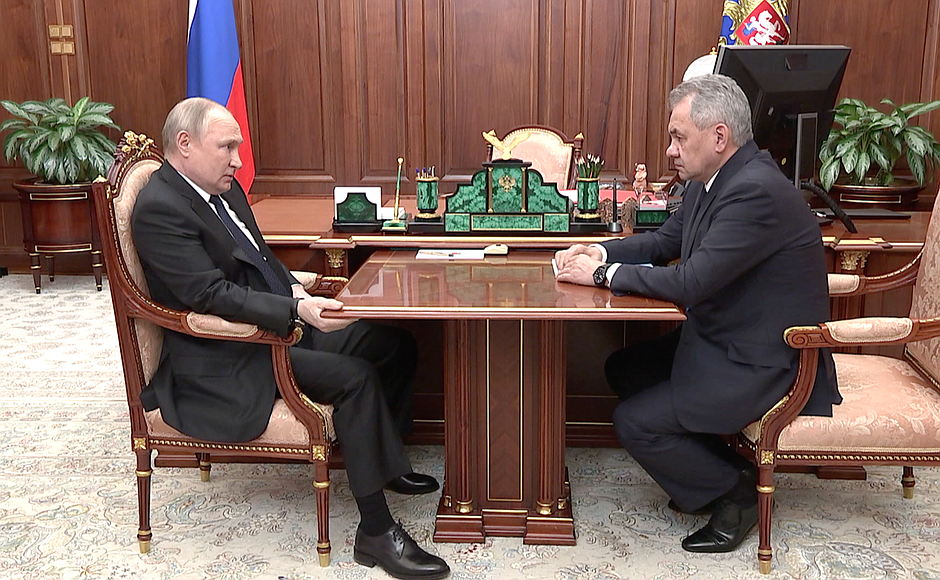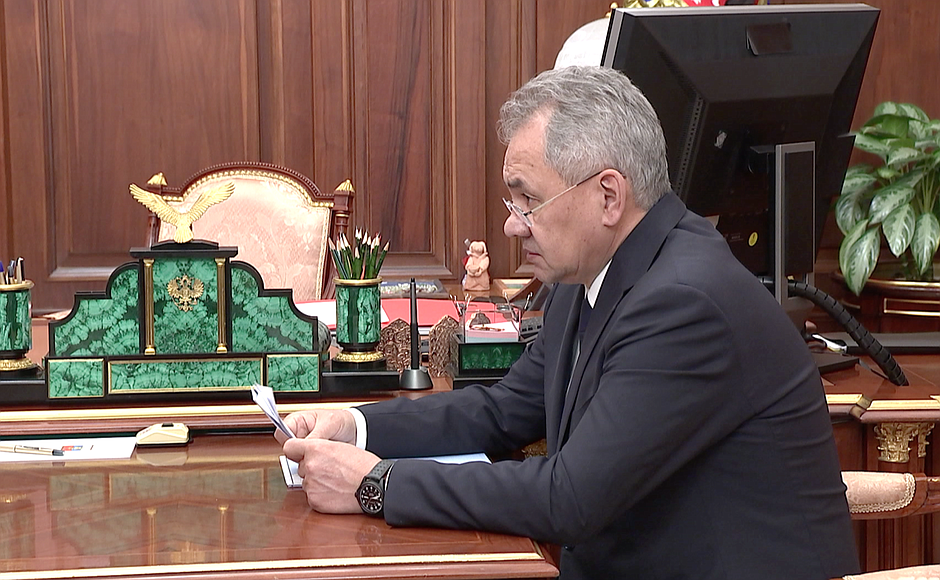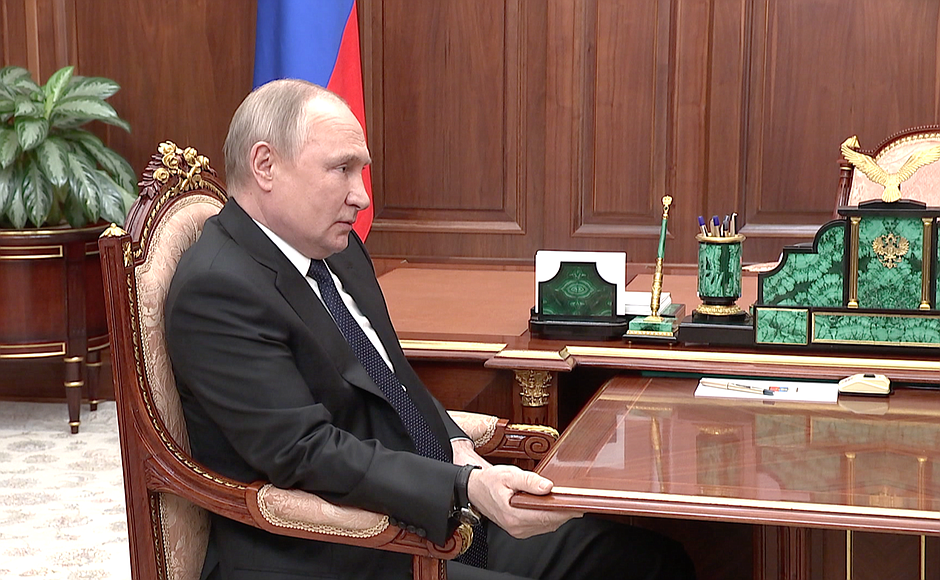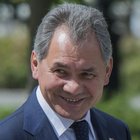Defence Minister Sergei Shoigu: Mr President,
The Armed Forces of the Russian Federation and the people’s militia of the Donetsk People’s Republic have liberated Mariupol. The remaining nationalists are hiding in the industrial area of the Azovstal steel plant.
Mariupol is a major industrial centre and the main transport hub on the Sea of Azov. In 2014, the Kiev regime declared the city the temporary capital of the Donetsk Region, and during the subsequent eight years it has been turned into a powerful stronghold and the base of far-right Ukrainian nationalists. In fact, it was the capital of the Azov Battalion.
A large amount of heavy weaponry and military hardware have been deployed in the city, including tanks, the Smerch and Uragan multiple rocket launcher systems, heavy artillery systems and the Tochka-U missile complexes. Tochka-U has a range of 120 kilometres, while the distance from Mariupol to Russia’s city of Taganrog is 94 kilometres and approximately the same to Rostov, the capital of the Southern Federal District.
The city has been stocked with missiles, munitions, fuel and lubricants, and food provisions for lengthy hostilities. The main infrastructure facilities, including the seaport and the waterway, have been mined and blocked with floating cranes. The majority of vessels there belong to foreign states.
As for armoured vehicles, there were 179 tanks and armoured fighting vehicles there, 170 various guns and mortars, including multiple rocket launchers which I have already mentioned, the Smerch and Uragan systems. When the city was surrounded on March 11, there were more than 8,100 troops of the Ukrainian Armed Forces and nationalist units in the city, as well as foreign mercenaries, who formed a large group. During the operation to liberate the city, over 4,000 of them have been neutralised, 1,478 have surrendered, and the remaining group of over 2,000 has been blocked in the industrial area of the Azovstal plant.
In their resistance efforts, the nationalists used almost all residential buildings as fortified emplacements. Armoured vehicles and artillery were placed on ground floors, and snipers took up positions on upper floors. There were separate units armed with ATGMs as well. The residents were brought to the middle floors and basements and used as human shields. It was done in almost every block of flats.
When retreating, the Ukrainian army and the nationalist battalions in Mariupol and other Ukrainian cities were using civilians as a cover. We are aware of four instances when, in order to cover their retreat, they made people leave the basements. The latest incident was literally four days ago, when we were liberating the port area and they made almost everyone leave high-rise buildings so that they could flee leaving behind ruins, including completely destroyed socially important and cultural sites.
While liberating Mariupol, the Russian army and the people's militia units from the DPR took every precaution to save civilian lives. Mr President, as you instructed, humanitarian corridors have been created daily since March 21 to evacuate civilians and foreign nationals.
Servicemen of the Ukrainian Armed Forces and militants from nationalist battalions were encouraged to lay down their arms. Of course, they were guaranteed life, safety and medical help.
We remained in daily communication with Deputy Prime Minister of Ukraine [Irina] Vereshchuk with regard to planned humanitarian acts, which included corridors and transport, both ambulances and buses. Occasionally, up to 100 such buses and 25 to 30 ambulances were made available per day.
Foreign diplomatic missions got in touch with us in various ways because their nationals were there. By the way, we have been able to free and evacuate many of them from Mariupol as part of these humanitarian initiatives. We provided official notifications to the Office of the UN High Commissioner for Refugees, the relevant OSCE structures, the International Committee of the Red Cross and other international organisations stating the time and place of these initiatives. In some instances, we even insisted on their presence to make sure that all the humanitarian rules are complied with to the extent it was possible, considering the constant and never-ending fire coming from the nationalist battalions and the Ukrainian Armed Forces.
Despite the resistance of the fighters and all others, we were able to evacuate 142,711 civilians from Mariupol after you issued instructions to this effect. We freed all hostages at the seaport, including sea crews. Those who took them hostage damaged their communications systems so that they could not get in touch with anyone. The port was mined, and the waterway blocked. I hope that these ships will now be able to leave this port.
As of today, the Russian Army and the Donetsk People’s Republic’s people’s militia control all of Mariupol, reliably blocking Azovstal territory with what remains of the nationalist forces and foreign mercenaries.
Over the past two days, again as per your instructions, we declared a ceasefire between 2 pm and 4 pm, stopped all military action and opened humanitarian corridors to enable civilians who may be at Azovstal to leave.
We prepared about 90 buses for them, and 25 ambulances. Of course, considering all the distortions we face, we installed Russian Aerospace Forces cameras and received the stream almost in real time here at the command centre. No one left Azovstal. However, other civilians, over 100 of them, were able to leave. This was a major effort for us over the past few days, and we carried it out together with all the relevant international organisations.
The city is now calm, which allows us to begin efforts to restore order, enable people to return to their homes and bring peaceful life back to the city. As for those hiding at Azovstal, we have reliably sealed its perimeter, and need three or four days to complete this effort at Azovstal.
This concludes my report.
President of Russia Vladimir Putin: I believe it would be inadvisable to storm this industrial zone.
I order you to cancel it.
Sergei Shoigu: Yes, sir.
Vladimir Putin: This is the case when we have to prioritise preserving the lives and health of our soldiers and officers. Of course, this is our constant priority, but even more so in this case. There is no need to penetrate these catacombs and crawl under these industrial facilities.
Seal off the industrial zone completely.
Sergei Shoigu: Yes, sir.
Vladimir Putin: You must offer all those who have not laid down their weapons to do so. Russia guarantees them their lives and dignity as per the relevant international legal instruments. All the wounded will get medical assistance.
You successfully completed the combat effort to liberate Mariupol. Let me congratulate you on this occasion, and please convey my congratulations to the troops. I am also asking you to submit proposals on bestowing state decorations on the service personnel who distinguished themselves. Of course, as usual, there will be various decorations, but I want everyone to know that they are all heroes for us and for all of Russia.
In this context, we need to make sure that we fulfil all the social commitments to our service personnel, especially the wounded and the families of our fallen comrades.
However, I believe that this would not be enough. We have to do more and come up with additional support measures, and in some case to consider ways of perpetuating the memory of those of our comrades who displayed heroism and sacrificed their lives so that our people in Donbass live in peace and to enable Russia, our country, to live in peace. These people deserved this by what they did and the way they honoured their oath.
I am asking you to work on this matter within the Defence Ministry, while I will issue the corresponding instructions to the Presidential Executive Office. I will talk to my colleagues in the regions, and they will work with the municipalities across Russia.
Assuming control over Mariupol, a major city in the south of the country, is obviously a success. Congratulations.
Sergei Shoigu: Thank you, Mr President.



